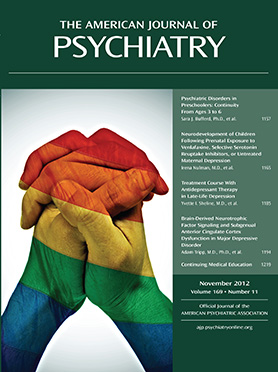Although the field of infant/preschool mental health is not young, it has been met with high levels of skepticism and has yet to be well integrated into mainstream psychiatry. As outlined by Bufferd et al. in their landmark paper in this issue (
1), efforts to empirically investigate and validate mental disorders in early childhood have faced a number of impediments. These have included concern that diagnostic labels might stigmatize young children; the lack—until recently—of developmentally sensitive, age-appropriate measures of psychopathology that make accurate distinctions from developmental norms; and, perhaps most importantly, a long-held underlying belief that early emotional and behavioral problems represent normative extremes that young children simply grow out of. Bufferd and colleagues’ longitudinal study of a large community sample adds to the literature and provides some of the most rigorous broad-based data to date refuting this notion.
Building on the growing body of literature validating the onset of numerous axis I psychiatric disorders as early as age 3 (
2–
5), Bufferd et al. provide findings from a relatively large community sample of 3-year-old children assessed using a comprehensive interviewer-based diagnostic interview (among other measures) and followed longitudinally to age 6. As the authors point out, unique features of the study design included the community-based sampling and the use of a rigorous and comprehensive diagnostic interview designed specifically to assess discrete disorders in preschoolers (as opposed to more commonly used generic checklist measures).
The study findings clearly demonstrated that the manifestation of symptoms meeting DSM-IV criteria for clinical disorders at age 3 was a robust marker of risk for disorders at age 6. Both homotypic and heterotypic continuity were demonstrated. Notably, having a disorder at age 3 was associated with an almost fivefold greater risk of having a disorder at age 6. Conversely, more than 50% of children who met criteria for a disorder at age 6 already had clinically significant symptoms by age 3. One limitation of the study was that the age 6 assessment was done by telephone rather than in person as was done at the age 3 assessment. Another was that the diagnosis was based on parental report and was not supplemented by observational data, thereby introducing possible bias that cannot be offset by child report (since young children have a limited ability to self-report on symptoms directly). It should be noted, however, that the use of parent informants in research diagnostic assessments of young children stands as the state of the art today, despite some promising efforts to develop feasible valid and reliable observational tools that map onto diagnostic algorithms (
6). Notwithstanding these limitations, the study findings clearly add broad evidence supporting the relative stability, rather than transience, of early forms of psychopathology and therefore the importance of early identification and intervention.
Studies of childhood development have increasingly validated and elucidated two central principles over the past several decades. One is that infants and young children are far more cognitively and emotionally competent than previously assumed. The other is that the early developmental trajectory is steep in numerous domains, including emotional and behavioral, and is characterized by relatively high neuroplasticity (
7,
8). This body of work in combination with the findings presented here by Bufferd et al. underscore the critical public health opportunity afforded by the identification of mental disorders in early childhood. Intervention studies from a wide variety of disciplines and domains now suggest that earlier intervention may have more powerful effects than later interventions. A large body of literature demonstrating this effect in early childhood disruptive disorders has been available for several decades (
9), and a growing body of work suggests a similar effect in the treatment of autism spectrum disorders (
10). This principle has long been central to the treatment of general developmental disorders in childhood, such as speech and language disorders and motor disorders.
The field of psychiatry, facing the need to develop more powerful and effective treatments, has been searching for new models to conceptualize disorders and to understand mechanisms of risk (
11). Along this line, there has been an increasing focus on understanding the developmental underpinnings of disorders so that they may be identified before they are full-blown and, in some cases, on the path to chronicity. In this light, the findings of Bufferd et al. should blow new wind into the sails of efforts to identify and define the earliest-onset forms of mental disorders. Such work may help us understand the developmental pathways of adult disorders and develop new methods for intervening earlier in life, during periods of greater developmental change and plasticity.

